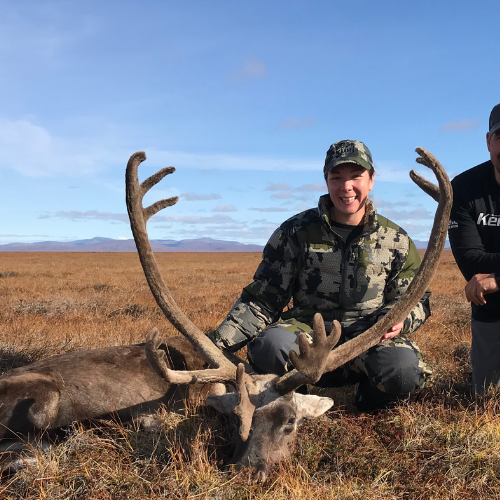Caribou Hunting Trips
Caribou (Rangifer tarandus) are large, stout members of the deer family, with concave hooves that splay to support the animal in snow or soft tundra and which function as paddles in water. Caribou live in the arctic tundra, mountain tundra, and northern forests of North America, Russia, and Scandinavia. Although they are called reindeer in Europe, only domesticated caribou are called reindeer in Alaska and Canada.
Available Caribou Hunts
Caribou Hunting With Tru Flight Adventures
Caribou in Alaska are distributed in 32 herds (or populations) totaling approximately 950,000 animals. This includes in herds shared with Canada’s Yukon Territory. Although each herd uses its own unique calving area, different herds may mix together while on their winter ranges. Many herds winter in the boreal forest, but during the remainder of the year caribou prefer treeless tundra and mountains where they can get relief from biting insects.
First, we should distinguish the terminology that is used to define both caribou and reindeer. Like most hunting outfitters, we use “caribou” to refer to North American animals, then we use “reindeer” to Eurasian populations. With that being said, it’s important to note that these animals are basically the same.
In total, there’s a wide range of caribou variations that are recognized, this includes but is not limited to Quebec Labrador, Barren Ground, mountain and woodland, but the differences between lie mostly in habitat and behavior, not genetics. Caribou are the creature of the North, and inhabit the tundra, forest tundra and northern forest across North America. Non-resident hunting seasons are open in Alaska, a number of Canadian provinces including Yukon, British Columbia and Newfoundland and Labrador, and Greenland (although that’s technically Europe, as Greenland is part of the Kingdom of Denmark).
When Can You Hunt Caribou?
The caribou season typically starts in August and closes in November-December. However, in order to harvest a bull with antlers in prime shape, the hunter has to schedule the hunt in September or October: after the antlers are out of the velvet stage, but before the bulls shed them, which happens immediately after the rut. This is usually the best time to visit the boreal landscapes anyway, with mosquitos already gone and winter colds, snows and polar night not yet in. Hunting Barren Ground caribou and other tundra populations typically takes place during their autumn migration. In most cases caribou follow the same migration pattern from year to year, but occasionally for no apparent reason they arrive at a different time or take another way. That’s why some caribou outfitters prefer not to schedule hunts in advance, but to call hunters in when the deer arrive.
Why Hunt Caribou?
It’s amazing how creatures like caribou can adapt to harsh environment of the Arctic. One such adaptation is beautiful thick coat that partly consists of semi-hollow hairs. The other is antlers. Both bull and cow caribou carry antlers, with a unique and very individual shape combining a palm and numerous points with well developed eye guards, but the bulls drop their antlers before winter, and cows retain them until springtime (to protect their calving ground). Residents of caribou habitat also pursue them for their delicious meat, but a hunter that wants to get a pair of prime bull antlers would need to hunt during the rut, when caribou bull meat may be unpalatable. But the prime attraction for caribou hunting is probably the chance to see and live in the amazing, out-of-this-planet caribou habitat in the tundra and the boreal forest.
